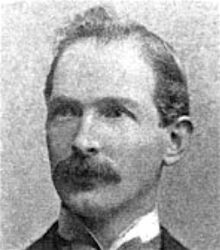
James Glen Sivewright Gibson [also known as James Gibson; and as James S. Gibson] born in Arbroath, Tayside, Scotland on 23 November 1861 and was articled to David Maclaren (1848-1887) of Ireland & Maclaren, School Board Architects in Dundee, from 1877 to 1881. He was then employed as a draughtsman by Pearce Brothers, engineers and Alexander Hutcheson (c.1842-1917), following which he moved to London where he worked as an assistant to William Wallace and Harry Wilkinson Moore (1850-1915). He also worked in the office of Thomas Edward Collcutt (1840-1924).
Gibson commenced independent practice as an architect in London 1889 and passed his professional exam the following year. He was in partnership with Samuel Bridgman Russell (1864-1955) as Gibson & Russell from 1890 to 1900; with William Wallace as Wallace & Gibson from c.1900 to 1909; with Frank Peyton Skipworth (1881-1915) and Walter Symington Athol Gordon (1879-1968) as Gibson, Skipwith & Gordon from 1909 to c.1914; and, following the death of Skipwoth in 1915 whist serving in the Arming during World War One, as Gibson & Gordon until c.1922.
Gibson was elected an Associate of the Royal Institute of British Architects (ARIBA in 1890 and a Fellow of the Royal Institute of British Architects (FRIBA) in 1902. He died in London on 27 March 1951.
A biographical file on James Glen Sivewright Gibson is available on request from the Enquiry Desk, Royal Institute of British Architects Library, London
London County Council Hostel for Working Men, Parker Street, Covent Garden, London (1891); West Riding County Hall, Wood Street, Wakefield, Yorkshire, with S.B. Russell (1894-98); West Ham West Ham Municipal Technical Institute, Library and Museum, Romford Road, West Ham, London, with S.B. Russell (1895-98); Passmore Edwards Museum, West Ham, London, with S.B. Russell (1900); Central Library, Albium Street, Hull, Yorkshire (1900-01); Walsall Town Hall and Library, Leicester Street, Walsall, Staffordshire (1901-05); Mexborough House, 33 Dover Street, London (1905-06); alterations to Caxton Hall, Westminster (1906); Middlesex Guildhall, Parliament Square, Westminster, London (1906-13); Debenham & Freebody department store, Wigmore Street, London (1907-09); Arding & Hobbs department store, Lavender Hill, Battersea, London (1910); and Portsmouth War Memorial, with W.S.A. Gordon (1921). He also designed offices for the Scottish Equitable Assurance Society, 13 Cornhill, London; St. Jameses's Hospital, Balham, London; and Parnall's Store, Wilton Road, London
Directory of British Architects 1834-1914. Compiled by Antonia Brodie, et al. Volume 1: A-K. London; New York: British Architectural Library, Royal Institute of British Architects/Continuum, 2001
Gray, A. Stuart. Edwardian architecture: a biographical dictionary.. London: Gerald Duckworth & Co., Ltd., 1985
Marriott, Charles. Modern English Architecture. London: Chapman & Hall, 1924
'Obituary'. The Builder 11 June 1951 p. 663
'Obituary'. RIBA Journal June 1951 p. 332
Who's Who in Architecture 1914. London: Technical Journals Ltd., 1914